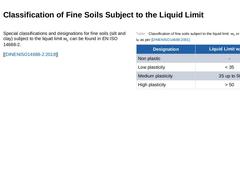
|
Special classifications and designations for fine soils (silt and clay) subject to the liquid limit wL can be found in EN ISO 14688-2. [ [DINENISO14688-2:2018]] (Table: Classification of fine soils subject to the liquid limit wL or plasticity index IP as per EN ISO 14688-2) |
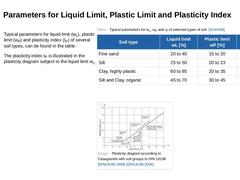
|
|
Typical parameters for liquid limit (wL), plastic limit (wP) and plasticity index (IP) of several soil types, can be found in the table. The plasticity index IP is illustrated in the plasticity diagram subject to the liquid limit wL. |
(Table: Typical parameters for wL, wP and IP of selected types of soil) (Image: Plasticity diagram according to Casagrande with soil groups to DIN 18196) |
|

|
|
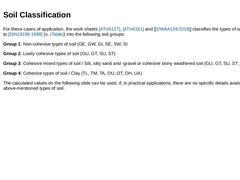
|
For these cases of application, the work sheets [ATVA127], [ATVA161] and [ [DWAA139:2019]] classifies the types of soil according to [DIN18196:1988] (s. (→ Table: Soil classification for engineering purposes in accordance with DIN 18196 (05.2011))) into the following soil groups: Group 1: Non-cohesive types of soil (GE, GW, GI, SE, SW, SI Group 2: Lowly cohesive types of soil (GU, GT, SU, ST) Group 3: Cohesive mixed types of soil / Silt, silty sand … |
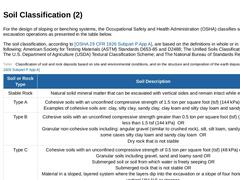
|
For the design of sloping or benching systems, the Occupational Safety and Health Administration (OSHA) classifies soils from excavation operations as presented in the table below. The soil classification, according to [[OSHA 29 CFR 1926 Subpart P App A]], are based on the definitions in whole or in part, the following; American Society for Testing Materials (ASTM) Standards D653-85 and D2488; The Unified Soils Classification System; The U.S. Department … |
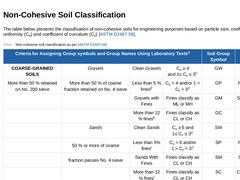
|
The table below presents the classification of non-cohesive soils for engineering purposes based on particle size, coefficient of uniformity (Cu) and coefficient of curvature (Cc) [[ASTM D2487-06]]. (Table: Non-cohesive soil classification as per ASTM D2487) |
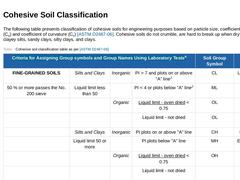
|
The following table presents classification of cohesive soils for engineering purposes based on particle size, coefficient of uniformity (Cu) and coefficient of curvature (Cc) [[ASTM D2487-06]]. Cohesive soils do not crumble, are hard to break up when dry and include clayey silts, sandy clays, silty clays, and clays. (Table: Cohesive soil classification as per ASTM D2487) |
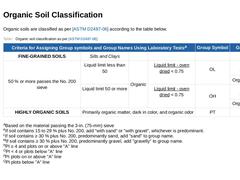
|
Organic soils are classified as per [[ASTM D2487-06]] according to the table below. (Table: Organic soil classification as per ASTM D2487) |
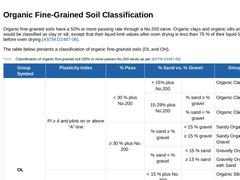
|
Organic fine-grained soils have a 50% or more passing rate through a No.200 sieve. Organic clays and organic silts are soils that would be classified as clay or silt, except that their liquid limit values after oven drying is less than 75 % of their liquid limit value before oven drying [[ASTM D2487-06]]. The table below presents a classification of organic fine-grained soils (OL and OH). (Table: Classification of organic fine-grained soil (50% or … |
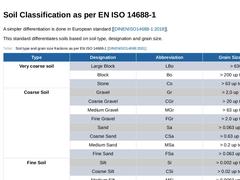
|
A simpler differentiation is done in European standard [ [DINENISO14688-1:2018]]. This standard differentiates soils based on soil type, designation and grain size. (Table: Soil type and grain size fractions as per EN ISO 14688-1) |
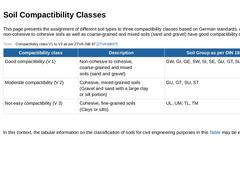
|
This page presents the assignment of different soil types to three compactibility classes based on German standards. As per ASTM, non-cohesive to cohesive soils as well as coarse-grained and mixed soils (sand and gravel) have good compactibility characteristics. (Table: Compactibility class V1 to V3 as per ZTVA-StB 97) In this context, the tabular information on the classification of soils for civil engineering purposes in this (→ Table: Soil classification … |
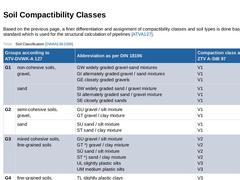
|
Based on the previous page, a finer differentiation and assignment of compactibility classes and soil types is done based on German standard which is used for the structural calculation of pipelines [ATVA127]. (Table: Soil Classification (DWA-A 139)) Further soil characteristics according to EAU 1996 can be found in the following (→ Table: Soil characteristics draft (e 9) of EAU 1996) |
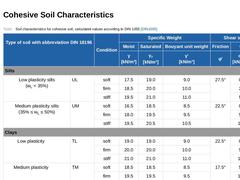
|
(Table: Soil characteristics for cohesive soil, calculated values according to DIN 1055) |

|
|

|
|
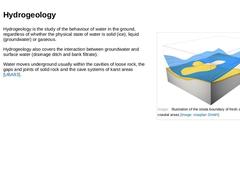
|
(Image: Illustration of the strata boundary of fresh and salt water in coastal areas) Hydrogeology is the study of the behaviour of water in the ground, regardless of whether the physical state of water is solid (ice), liquid (groundwater) or gaseous. Hydrogeology also covers the interaction between groundwater and surface water (drainage ditch and bank filtrate). Water moves underground usually within the cavities of loose rock, the gaps and joints … |

|
In the given case of application, hydrogeological investigations are particularly used to determine the: -
Groundwater level
-
Flow velocity and direction
-
Permeability
-
Accruing water quantity
-
Hydrostatic pressure condition
-
Chemistry of the groundwater
|
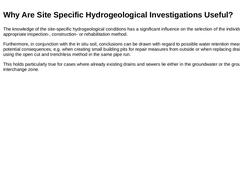
|
The knowledge of the site-specific hydrogeological conditions has a significant influence on the selection of the individually appropriate inspection-, construction- or rehabilitation method. Furthermore, in conjunction with the in situ soil, conclusions can be drawn with regard to possible water retention measures and their potential consequences, e.g. when creating small building pits for repair measures from outside or when replacing drains and … |
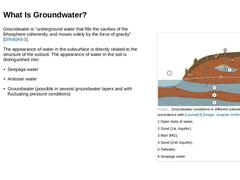
|
(Image: Groundwater conditions in different subsoil strata in accordance with [Lauma83]) Groundwater is "underground water that fills the cavities of the lithosphere coherently, and moves solely by the force of gravity" [DIN4049-3]. The appearance of water in the subsurface is directly related to the structure of the subsoil. The appearance of water in the soil is distinguished into: |
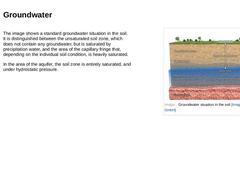
|
The image shows a standard groundwater situation in the soil. It is distinguished between the unsaturated soil zone, which does not contain any groundwater, but is saturated by precipitation water, and the area of the capillary fringe that, depending on the individual soil condition, is heavily saturated. In the area of the aquifer, the soil zone is entirely saturated, and under hydrostatic pressure. (Image: Groundwater situation in the soil) |
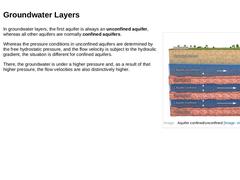
|
(Image: Aquifer confined/unconfined) In groundwater layers, the first aquifer is always an unconfined aquifer, whereas all other aquifers are normally confined aquifers. Whereas the pressure conditions in unconfined aquifers are determined by the free hydrostatic pressure, and the flow velocity is subject to the hydraulic gradient, the situation is different for confined aquifers. There, the groundwater is under a higher pressure and, as a result of … |
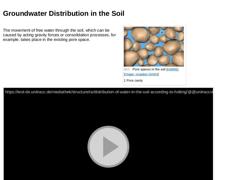
|
The movement of free water through the soil, which can be caused by acting gravity forces or consolidation processes, for example, takes place in the existing pore space. (Image: Pore cavity in the soil [Hölti96]) Video: Distribution of water in the soil (according to Hölting, 1994) [Animation: visaplan GmbH]. This interactive object is only visible in the online version of the module. (Video: Distribution of water in the soil according to Hölting) |
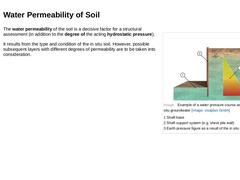
|
(Image: Example of a water pressure course as a result of the in situ groundwater) The water permeability of the soil is a decisive factor for a structural assessment (in addition to the degree of the acting hydrostatic pressure). It results from the type and condition of the in situ soil. However, possible subsequent layers with different degrees of permeability are to be taken into consideration. |

|
|
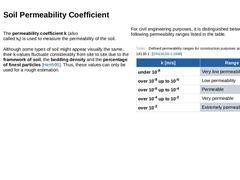
|
The permeability coefficient k (also
called kf) is used to measure the permeability of the soil. Although some types of soil might appear visually the same, their k-values fluctuate considerably from site to site due to the framework of soil, the bedding density and the percentage of finest particles [Herth95]. Thus, these values can only be used for a rough estimation. For civil engineering purposes, it is distinguished between the following permeability … |